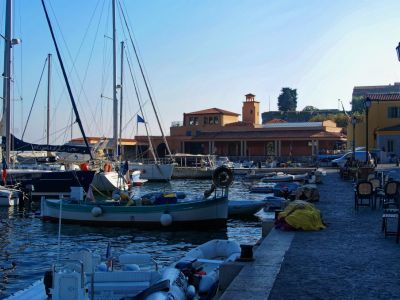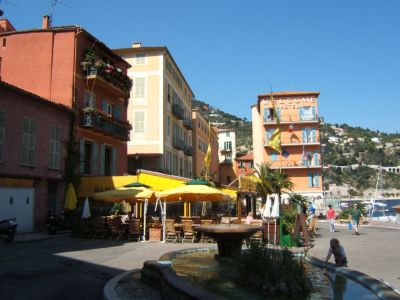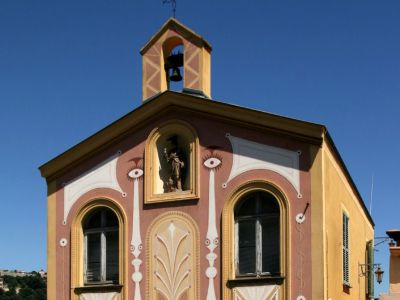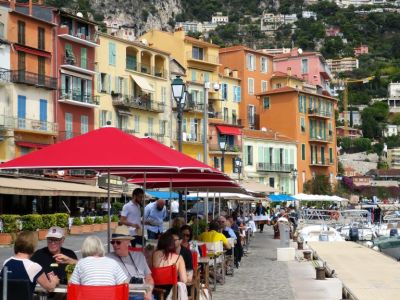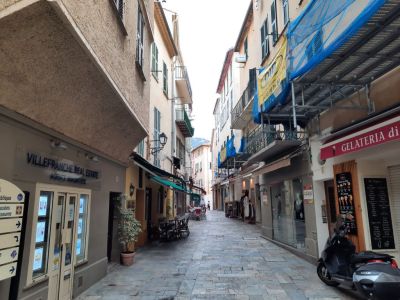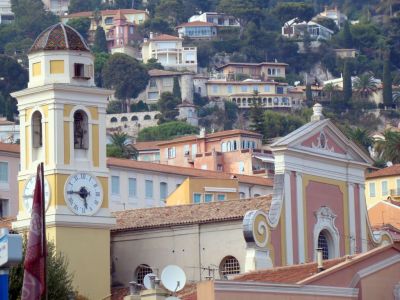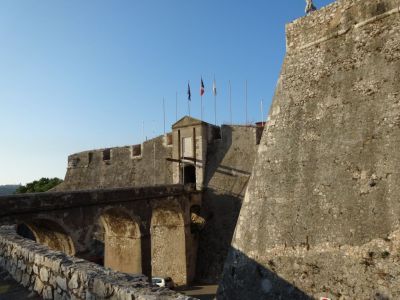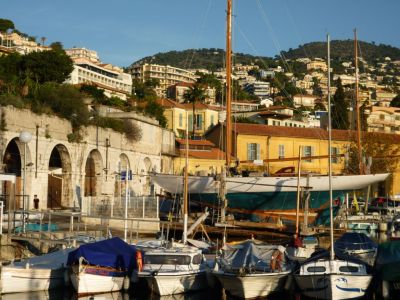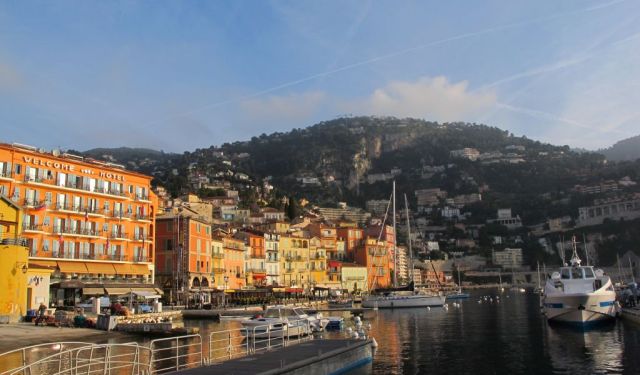
Villefranche-sur-Mer Introduction Walking Tour (Self Guided), Villefranche-sur-Mer
Nestled along the glittering French Riviera, Villefranche-sur-Mer mixes historic charm and modern Mediterranean zest like a perfect cocktail. Founded in the 13th century, this scenic town started life as a strategic coastal stronghold to fend off maritime invaders. Its name literally translates to "free town," thanks to tempting tax breaks aimed at attracting settlers—because, really, who can resist a good tax deal?
The town's postcard-perfect bay, naturally deep and sheltered, quickly turned Villefranche into a crucial naval port. In the 16th century, its importance was sealed by the construction of the Citadel of Saint-Elme, built under the vigilant watch of the Duke of Savoy. Today, this fortress swaps cannons for culture, with museums, lush gardens, and stunning views of the bay and coastline.
Meanwhile, the picturesque Old Town enchants with its narrow, winding streets, pastel-colored buildings, and general atmosphere. Don't miss Rue Obscure, a covered medieval street and one of the town's most intriguing features. Another must-see is the nearby promenade that buzzes with cafés and restaurants—perfect for lazy afternoons spent yacht-spotting.
Throughout the 20th century, Villefranche became a magnet for artists, writers, and celebrities, all irresistibly drawn by the many inspiring vistas. The bay has even caught Hollywood's eye, serving as the backdrop for countless films—including Alfred Hitchcock's classic "To Catch a Thief."
Ready to dive in? Lace up your walking shoes and let our self-guided tour lead you through every captivating corner of this beloved Mediterranean destination.
The town's postcard-perfect bay, naturally deep and sheltered, quickly turned Villefranche into a crucial naval port. In the 16th century, its importance was sealed by the construction of the Citadel of Saint-Elme, built under the vigilant watch of the Duke of Savoy. Today, this fortress swaps cannons for culture, with museums, lush gardens, and stunning views of the bay and coastline.
Meanwhile, the picturesque Old Town enchants with its narrow, winding streets, pastel-colored buildings, and general atmosphere. Don't miss Rue Obscure, a covered medieval street and one of the town's most intriguing features. Another must-see is the nearby promenade that buzzes with cafés and restaurants—perfect for lazy afternoons spent yacht-spotting.
Throughout the 20th century, Villefranche became a magnet for artists, writers, and celebrities, all irresistibly drawn by the many inspiring vistas. The bay has even caught Hollywood's eye, serving as the backdrop for countless films—including Alfred Hitchcock's classic "To Catch a Thief."
Ready to dive in? Lace up your walking shoes and let our self-guided tour lead you through every captivating corner of this beloved Mediterranean destination.
How it works: Download the app "GPSmyCity: Walks in 1K+ Cities" from Apple App Store or Google Play Store to your mobile phone or tablet. The app turns your mobile device into a personal tour guide and its built-in GPS navigation functions guide you from one tour stop to next. The app works offline, so no data plan is needed when traveling abroad.
Villefranche-sur-Mer Introduction Walking Tour Map
Guide Name: Villefranche-sur-Mer Introduction Walking Tour
Guide Location: France » Villefranche-sur-Mer (See other walking tours in Villefranche-sur-Mer)
Guide Type: Self-guided Walking Tour (Sightseeing)
# of Attractions: 9
Tour Duration: 1 Hour(s)
Travel Distance: 1.4 Km or 0.9 Miles
Author: nataly
Sight(s) Featured in This Guide:
Guide Location: France » Villefranche-sur-Mer (See other walking tours in Villefranche-sur-Mer)
Guide Type: Self-guided Walking Tour (Sightseeing)
# of Attractions: 9
Tour Duration: 1 Hour(s)
Travel Distance: 1.4 Km or 0.9 Miles
Author: nataly
Sight(s) Featured in This Guide:
- Port de la Sante (Port of Health)
- Place Amelie Pollonais (Amelie Pollonais Square)
- Chapelle Saint-Pierre (Saint Peter's Chapel)
- Quai de l'Amiral Courbet (Admiral Courbet Quay)
- Rue Obscure (Dark Street)
- Rue du Poilu (Street of the Soldier)
- Eglise Saint-Michel (Saint Michael's Church)
- Musees de la Citadelle (Citadelle Museums)
- Port de la Darse (Port of the Dock)
1) Port de la Sante (Port of Health)
The Port of Health (Port de la Sante) in Villefranche-sur-Mer is a picturesque and historic maritime hub on the French Riviera. Nestled between Nice and Monaco, this small yet strategically important port has long served as a gateway to one of the region’s most charming fishing villages. Today, it is a major cruise stop, welcoming over 200,000 passengers annually. With its deep, natural harbor and sheltered location, the port offers a breathtaking approach, especially at sunset, with steeply terraced streets rising behind the waterfront.
Since Villefranche is a tender port, cruise passengers arrive via small boats that dock at the jetty on the western side of the village. The Cruise Terminal serves as the arrival point, providing a tourist information desk with bus and train schedules for easy access to Nice, Monaco, and other destinations along the Côte d’Azur. Though small, the port operates efficiently, with French Navy mooring points in the bay allowing for the smooth anchoring of large cruise ships, guided by a pilot from the Port of Nice.
Located just north of the citadel, the Port of Health also accommodates fishing boats and a limited number of pleasure craft. Managed by the Departmental Council since 1984, it continues to balance maritime tourism with local fishing traditions. The surrounding area is vibrant with cafes, shops, and colorful houses, making it a delightful stop for visitors looking to experience the charm of Villefranche-sur-Mer before exploring the rest of the Riviera.
Since Villefranche is a tender port, cruise passengers arrive via small boats that dock at the jetty on the western side of the village. The Cruise Terminal serves as the arrival point, providing a tourist information desk with bus and train schedules for easy access to Nice, Monaco, and other destinations along the Côte d’Azur. Though small, the port operates efficiently, with French Navy mooring points in the bay allowing for the smooth anchoring of large cruise ships, guided by a pilot from the Port of Nice.
Located just north of the citadel, the Port of Health also accommodates fishing boats and a limited number of pleasure craft. Managed by the Departmental Council since 1984, it continues to balance maritime tourism with local fishing traditions. The surrounding area is vibrant with cafes, shops, and colorful houses, making it a delightful stop for visitors looking to experience the charm of Villefranche-sur-Mer before exploring the rest of the Riviera.
2) Place Amelie Pollonais (Amelie Pollonais Square)
Amelie Pollonais Square, the largest square in Villefranche-sur-Mer’s old town, is a lively and picturesque gathering spot nestled between the historic quarter and the waterfront. Adjoining the Port de la Sante and the quays, the square is lined with charming café and restaurant terraces, offering visitors the perfect place to soak in the Mediterranean atmosphere. Surrounded by pastel-colored facades, this vibrant square is a favorite for both locals and tourists looking to enjoy a relaxed meal while watching the gentle activity of the harbor.
The outdoor terraces are particularly inviting, allowing guests to dine al fresco with uninterrupted views of the sea. Whether sipping a morning coffee, indulging in a leisurely lunch, or enjoying an evening apéritif as the sun sets over the bay, the square provides an idyllic setting.
Named after Amelie Pollonais, a remarkable philanthropist and advocate for social causes, the square honors her contributions to education, the arts, and humanitarian efforts. Recognized for her work with the Red Cross and as the founder of various charitable societies, Pollonais left a lasting legacy in Villefranche-sur-Mer. After her passing, the square was renamed in her honor.
The outdoor terraces are particularly inviting, allowing guests to dine al fresco with uninterrupted views of the sea. Whether sipping a morning coffee, indulging in a leisurely lunch, or enjoying an evening apéritif as the sun sets over the bay, the square provides an idyllic setting.
Named after Amelie Pollonais, a remarkable philanthropist and advocate for social causes, the square honors her contributions to education, the arts, and humanitarian efforts. Recognized for her work with the Red Cross and as the founder of various charitable societies, Pollonais left a lasting legacy in Villefranche-sur-Mer. After her passing, the square was renamed in her honor.
3) Chapelle Saint-Pierre (Saint Peter's Chapel)
The Chapel of Saint Peter is a small yet remarkable place of worship near the port, dedicated to Saint Peter, the patron saint of fishermen. Likely dating back to the 16th century, it was traditionally used by local fishermen not only for prayer but also as a storage space for their gear and even as a place to resolve disputes. Its pink, yellow, and white façade makes it a standout landmark along the waterfront, blending into the charming maritime surroundings.
Inside, the chapel is a hidden artistic treasure, housing stunning frescoes painted by Jean Cocteau in 1957. This was Cocteau’s first painted chapel, and he masterfully depicted five main scenes—two illustrating Mediterranean life and three portraying moments from the life of Saint Peter. The fusion of spirituality and modern creativity makes the chapel a unique cultural landmark. Notably, Charlie Chaplin visited the chapel with Cocteau on July 18, 1957, adding to its storied history.
Today, the Chapel of Saint Peter remains under the ownership of Villefranche’s fishermen, a testament to its deep-rooted maritime connections. It was officially classified as a Historic Monument on December 27, 1996, ensuring its preservation for future generations.
Inside, the chapel is a hidden artistic treasure, housing stunning frescoes painted by Jean Cocteau in 1957. This was Cocteau’s first painted chapel, and he masterfully depicted five main scenes—two illustrating Mediterranean life and three portraying moments from the life of Saint Peter. The fusion of spirituality and modern creativity makes the chapel a unique cultural landmark. Notably, Charlie Chaplin visited the chapel with Cocteau on July 18, 1957, adding to its storied history.
Today, the Chapel of Saint Peter remains under the ownership of Villefranche’s fishermen, a testament to its deep-rooted maritime connections. It was officially classified as a Historic Monument on December 27, 1996, ensuring its preservation for future generations.
4) Quai de l'Amiral Courbet (Admiral Courbet Quay)
The Admiral Courbet Quay (Quai de l’Amiral Courbet) is one of the most scenic waterfront promenades in Villefranche-sur-Mer. Overlooking the picturesque bay, this lively quay is lined with fine restaurants and cafés, many of which offer tables right at the water’s edge. Visitors can dine while enjoying stunning views of luxury yachts and traditional fishing boats bobbing gently in the harbor. With the sea on one side and the colorful facades of Villefranche’s old town rising behind, the ambiance is quintessentially Mediterranean.
Dining options along the quay range from relaxed seafood bistros to elegant gourmet restaurants, all serving fresh, locally sourced ingredients. The Welcome Hotel’s bar and restaurant is a popular spot for a sunset aperitif, while the Tout Va Bien Hotel and Bar offers a charming setting for both drinks and dining. Whether indulging in freshly caught fish, sipping on a crisp rosé, or simply enjoying a coffee while watching the boats come and go, the quay provides an idyllic setting for a meal.
In addition to its vibrant dining scene, the Admiral Courbet Quay is a prime spot for a leisurely stroll. The occasional sports car may glide past, but the wide promenade is mainly a space for pedestrians, who can take in views stretching towards Villa Rothschild and Villa Kerylos along the dramatic coastline.
Dining options along the quay range from relaxed seafood bistros to elegant gourmet restaurants, all serving fresh, locally sourced ingredients. The Welcome Hotel’s bar and restaurant is a popular spot for a sunset aperitif, while the Tout Va Bien Hotel and Bar offers a charming setting for both drinks and dining. Whether indulging in freshly caught fish, sipping on a crisp rosé, or simply enjoying a coffee while watching the boats come and go, the quay provides an idyllic setting for a meal.
In addition to its vibrant dining scene, the Admiral Courbet Quay is a prime spot for a leisurely stroll. The occasional sports car may glide past, but the wide promenade is mainly a space for pedestrians, who can take in views stretching towards Villa Rothschild and Villa Kerylos along the dramatic coastline.
5) Rue Obscure (Dark Street) (must see)
Tucked beneath the old quarter of Villefranche-sur-Mer, Dark Street (Rue Obscure) is a hidden medieval passageway that transports visitors back in time. Stretching 130 meters (430 feet) beneath the village, this dimly lit tunnel-like street was originally built in 1260 for military purposes, allowing soldiers to move through the town unseen. Initially uncovered, it was part of the defensive roundabout along the first rampart. Over the centuries, as urbanization encroached, buildings were constructed over the street, sealing it off from daylight and creating the mysterious, shadowy corridor that remains today.
Despite its transformation, Dark Street never disappeared. Instead, it evolved into a passageway used for various purposes, including a makeshift wine cellar for local businesses and a shelter for livestock such as donkeys and goats. The street’s enclosed nature and medieval architecture, with its ancient stone walls and low arches, make it one of Villefranche-sur-Mer’s most fascinating historical landmarks. Visitors today can still see the Portal Robert, one of the four original access points to the fortified town.
Recognized as a Historic Monument since 1932, Dark Street is a must-visit for those exploring Villefranche’s Old Town. The tunnel-like path, illuminated only by scattered lamps or the occasional glow of a phone, retains an eerie yet enchanting atmosphere.
Despite its transformation, Dark Street never disappeared. Instead, it evolved into a passageway used for various purposes, including a makeshift wine cellar for local businesses and a shelter for livestock such as donkeys and goats. The street’s enclosed nature and medieval architecture, with its ancient stone walls and low arches, make it one of Villefranche-sur-Mer’s most fascinating historical landmarks. Visitors today can still see the Portal Robert, one of the four original access points to the fortified town.
Recognized as a Historic Monument since 1932, Dark Street is a must-visit for those exploring Villefranche’s Old Town. The tunnel-like path, illuminated only by scattered lamps or the occasional glow of a phone, retains an eerie yet enchanting atmosphere.
6) Rue du Poilu (Street of the Soldier)
The Street of the Soldier (Rue du Poilu) is the main thoroughfare of Villefranche-sur-Mer’s charming old town. Lined with beautifully preserved historic houses, this pedestrian-friendly street winds uphill from the harbor, flanked by pastel-colored facades in warm shades of orange, red, and yellow. The steep cobbled lanes and vibrant architecture create a picturesque setting, inviting visitors to explore the heart of the medieval town. Some of the buildings along the street even feature trompe-l'œil paintings, adding an artistic flair to the already captivating scene.
Historically known as Straight Street, the Street of the Soldier has always been the town’s main artery, stretching from one end of the fortified city to the other. In medieval times, gates at each end marked the limits of the town. During World War I, the street took on new significance, as it was the path soldiers followed from the citadel to the train station before departing for the front. In honor of these brave men, it was renamed Street of the Soldier, referencing the common nickname for French infantrymen—Poilu meaning "hairy," as soldiers in the trenches rarely had the chance to shave.
Today, Street of the Soldier remains a bustling center of local life, with its mix of traditional homes, small shops, and inviting cafés.
Historically known as Straight Street, the Street of the Soldier has always been the town’s main artery, stretching from one end of the fortified city to the other. In medieval times, gates at each end marked the limits of the town. During World War I, the street took on new significance, as it was the path soldiers followed from the citadel to the train station before departing for the front. In honor of these brave men, it was renamed Street of the Soldier, referencing the common nickname for French infantrymen—Poilu meaning "hairy," as soldiers in the trenches rarely had the chance to shave.
Today, Street of the Soldier remains a bustling center of local life, with its mix of traditional homes, small shops, and inviting cafés.
7) Eglise Saint-Michel (Saint Michael's Church) (must see)
Saint Michael’s Church is a Baroque Italianate church dating back to the 1750s. However, its religious history goes back much further, as it was built on the site of a 14th-century church, which itself replaced a 13th-century priory. The church has been a significant place of worship for centuries and was officially designated a historic monument in 1990.
The building follows a Latin cross plan, featuring a two-bay nave with round oculi above the side aisles. These aisles lead to a modest transept and a semicircular apse, which houses the choir. The church’s elegant Baroque design makes it a prominent architectural landmark in the town.
Inside, one of its notable treasures is a wooden statue of San Rocco, the patron saint of dog trainers. Another highlight is its magnificent 18th-century organ, considered one of the oldest working organs in the region.
The organ was built in 1790 by the Grinda brothers, well-known organ builders from Nice. Its ornate wooden case, crafted by Jean Antoine Mangiapan, was classified as a historic object in 1971. The church remains a cultural and historical gem, drawing visitors for its artistic beauty and sacred atmosphere.
The building follows a Latin cross plan, featuring a two-bay nave with round oculi above the side aisles. These aisles lead to a modest transept and a semicircular apse, which houses the choir. The church’s elegant Baroque design makes it a prominent architectural landmark in the town.
Inside, one of its notable treasures is a wooden statue of San Rocco, the patron saint of dog trainers. Another highlight is its magnificent 18th-century organ, considered one of the oldest working organs in the region.
The organ was built in 1790 by the Grinda brothers, well-known organ builders from Nice. Its ornate wooden case, crafted by Jean Antoine Mangiapan, was classified as a historic object in 1971. The church remains a cultural and historical gem, drawing visitors for its artistic beauty and sacred atmosphere.
8) Musees de la Citadelle (Citadelle Museums) (must see)
The Saint Elme Citadel is an impressive 16th-century fortress that dominates the coastline, offering both historical significance and breathtaking views of the Mediterranean. Built between 1554 and 1559 by the Duke of Savoy, Emmanuel Philibert, the citadel was strategically designed to defend the gulf from maritime attacks. Over the centuries, it has remained remarkably well-preserved, now serving as a cultural and civic hub that houses Villefranche’s town hall, lush public gardens, and a collection of fascinating museums.
Inside the citadel, visitors can explore the Volti Museum, which features the sensual bronze sculptures of Villefranche-born artist Antoniucci Volti, and the Goetz-Boumeester Museum, which exhibits modern art pieces in the former living quarters of the fortress. Additionally, the Royal Collection showcases an extensive display of ceramic figurines, vividly depicting life in medieval and Renaissance Europe.
Beyond its rich history and art collections, the citadel offers panoramic views from its ramparts, making it a must-see destination for visitors to Villefranche-sur-Mer. Walking along its fortified walls, one can admire the sweeping vistas of the bay, the terracotta-roofed village, and the deep blue sea beyond.
Inside the citadel, visitors can explore the Volti Museum, which features the sensual bronze sculptures of Villefranche-born artist Antoniucci Volti, and the Goetz-Boumeester Museum, which exhibits modern art pieces in the former living quarters of the fortress. Additionally, the Royal Collection showcases an extensive display of ceramic figurines, vividly depicting life in medieval and Renaissance Europe.
Beyond its rich history and art collections, the citadel offers panoramic views from its ramparts, making it a must-see destination for visitors to Villefranche-sur-Mer. Walking along its fortified walls, one can admire the sweeping vistas of the bay, the terracotta-roofed village, and the deep blue sea beyond.
9) Port de la Darse (Port of the Dock) (must see)
The Port of the Dock is a historic marina with roots dating back to 1550, when the Dukes of Savoy fortified its natural harbor. In 1713, as the rulers became Kings of Sardinia, the port gained its "Royal" title.
Major expansions began in 1730, introducing essential maritime infrastructure such as the lighthouse, dry-dock basin, arsenal, and forge. By 1770, additional structures, including the prison, rope factory, and officers’ barracks, further solidified its importance as a naval stronghold.
Today, the Dock has transitioned into a modern marina while maintaining its rich historical charm. Listed in the Historic Monuments Inventory since 1990, the port accommodates 520 boats, including vessels up to thirty meters in length, with services such as a harbor master’s office, electrical terminals, a fuel station, and a laundromat. The marina is a prime stopover for boaters, offering both functionality and breathtaking coastal scenery.
Major expansions began in 1730, introducing essential maritime infrastructure such as the lighthouse, dry-dock basin, arsenal, and forge. By 1770, additional structures, including the prison, rope factory, and officers’ barracks, further solidified its importance as a naval stronghold.
Today, the Dock has transitioned into a modern marina while maintaining its rich historical charm. Listed in the Historic Monuments Inventory since 1990, the port accommodates 520 boats, including vessels up to thirty meters in length, with services such as a harbor master’s office, electrical terminals, a fuel station, and a laundromat. The marina is a prime stopover for boaters, offering both functionality and breathtaking coastal scenery.
The Most Popular Cities
/ view all
